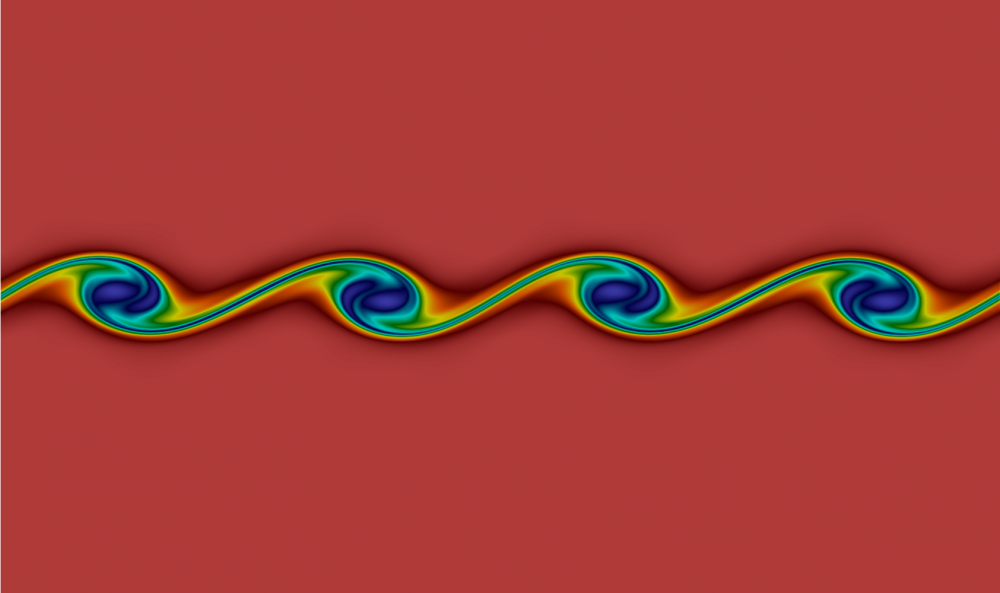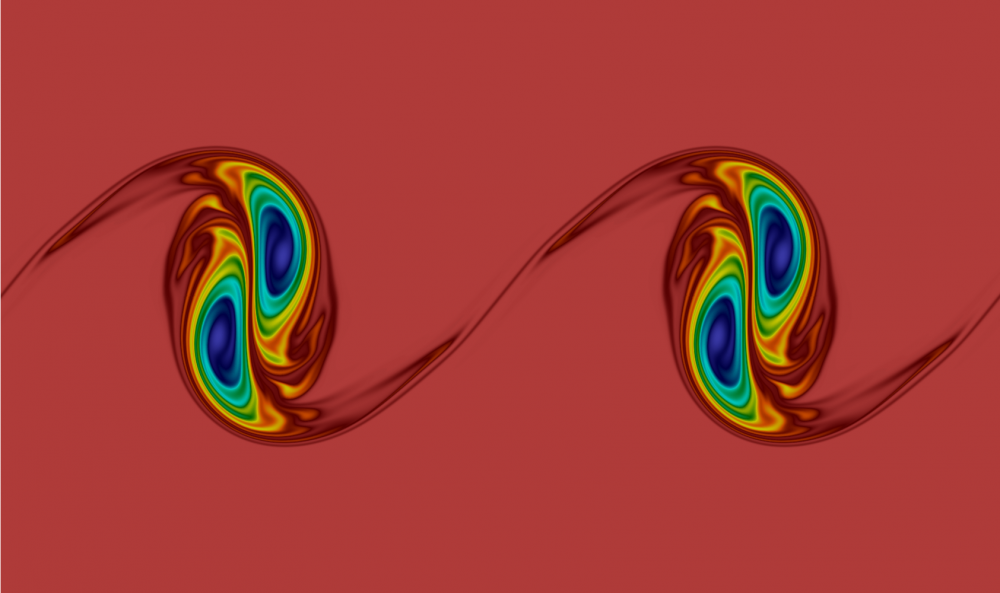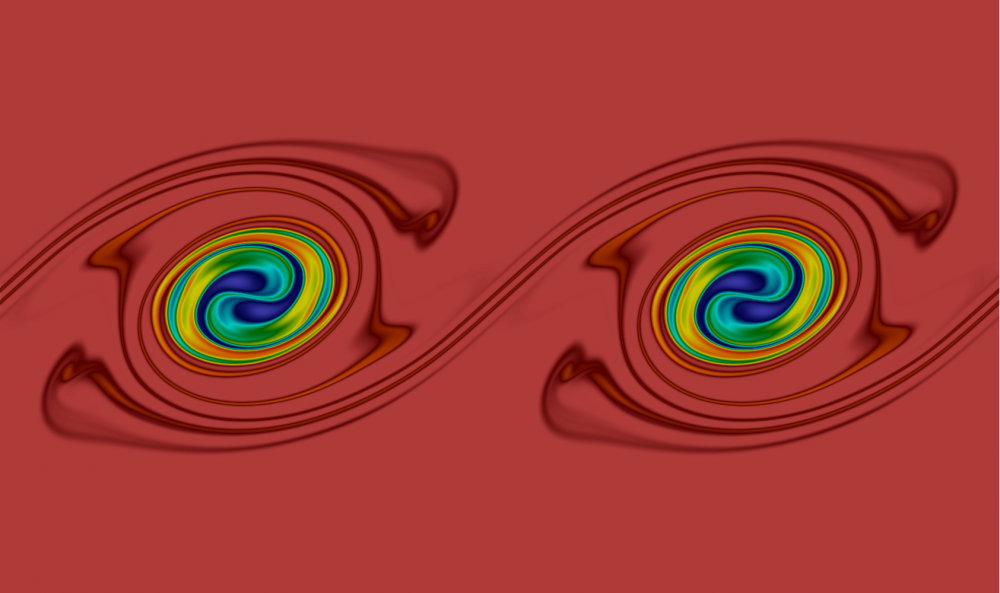Direct link to the data repository
Introduction
|
|
 |
 |
 |
This benchmark simulates the Kelvin-Helmholtz instability problem. We provide reference computations for this problem. On this page we describe the problem set up and give on overview on the quantities of interest. For simulation results and details that allow for a comparison of computational results we refer to our repository with our reference results.
Geometry and flow setup
The computation domain is a square $\Omega = [0,1]^2$.
The initial condition for the velocity $u$ is given by
$$ u_0(x,y) = \left(\begin{array}{c} u_\infty \text{tanh} ( \frac{2y-1}{\delta_0} ) \\ 0 \end{array} \right)+ c_n \left(\begin{array}{c} \partial_y \psi(x,y) \\ - \partial_x \psi(x,y) \end{array} \right)$$
with the stream function
$$
\psi(x,y)
= u_\infty \exp(-\frac{(y-0.5)^2}{\delta_0^2})
[ \cos (8\pi x) + \cos(20\pi x) ].
$$Here, $\delta_0=1/28$ denotes the initial vorticity thickness, $u_\infty=1$ is a reference velocity and $c_n=10^{-3}$ is a scaling/noise factor.
For the solution to the problem we consider the incompressible Navier-Stokes equations:
$$\frac{\partial u}{\partial t}+(u\cdot\nabla)u-\nu\Delta u+\nabla p = 0$$ $$\text{div}(u) = 0$$
At $x=0$ and $x=1$, periodic boundary conditions are prescribed and at $y=0$ and $y=1$, free-slip boundary conditions.
The Reynolds number $Re$ of the Kelvin--Helmholtz instability flow is usually calculated on the bases of the characteristic length scale $\delta_0$ and the characteristic velocity scale $u_\infty$, i.e., $Re= \delta_0 u_\infty/\nu = 1/(28\nu)$.
We consider different values for the viscosity $\nu$, such that we consider $Re\in \{ 100, 1000, 10000 \}$.
For the simulations and their evaluation, the time unit $\bar{t} = \delta_0/u_\infty$ is introduced. The time interval of interest is $[0,400\bar{t}]$. The flow is only driven by the inital data. There are no additional forces acting.
Quantities of interest
In the following we list the quantities of interested that have been collected for comparison:
1. Vorticity field at selected points in time
Vorticity, $\omega := \operatorname{curl}(u) = \partial_x u_2 - \partial_y u_1$ as a field on $\Omega$. Time points of interest are $t/\bar{t} \in \{5,10,17,34,36,180,220,257,400\}$. The pictures on the top of this page correspond to $t/\bar{t} \in \{10,34,36\}$.
2. Kinetic energy over time:
$$ \mathcal{K}(t,u) = \Vert u(t) \Vert_{L^2(\Omega)}^2, \qquad t/\bar{t} \in \{0,1,..,400\}$$
3. Kinetic energy spectra at selected points in time
$$ E(\kappa,t) = \int_{0}^1 \left| \int_0^1 u_1(t,x,y) e^{-i\kappa x} \, dx \right|^2 \, dy$$ Here, $u_1$ is the velocity in $x$-direction. Time points of interest are $t/\bar{t} \in \{5,10,17,34,36,180,220,257,400\}$.
4. Vorticity thickness over time
$$ \delta(t) = 2 u_{\infty} / \sup_{y\in (0,1)} | \langle \omega \rangle(t,y) |, \qquad t/\bar{t} \in \{0,1,..,400\} $$ where the integral mean vorticity in $x$-direction, $\langle \omega \rangle$ is defined as $$ \langle \omega \rangle := \int_0^1 \omega(t,x,y) \, dx $$ where $\omega = \operatorname{curl}(u) = \partial_x u_2 - \partial_y u_1$ is the vorticity of the flow.
5. Enstrophy over time
$$ \mathcal{E}(t,u) := \frac12 \Vert \omega(t) \Vert_{L^2(\Omega)}^2 = \frac12 \Vert \operatorname{curl}(u) \Vert_{L^2(\Omega)}^2, \qquad t/\bar{t} \in \{0,1,..,400\} $$
6. Palinstrophy over time
$$ \mathcal{P}(t,u) := \frac12 \Vert \nabla \omega(t) \Vert_{L^2(\Omega)}^2 = \frac12 \Vert \nabla \operatorname{curl}(u) \Vert_{L^2(\Omega)}^2, \qquad t/\bar{t} \in \{0,1,..,400\} $$
For further details we refer to the paper [1] and to our repository with our reference results.
References
- [1] Philipp W. Schroeder, Volker John, Philip L. Lederer, Christoph Lehrenfeld, Gert Lube, Joachim Schöberl, "On reference solutions and the sensitivity of the 2d Kelvin–Helmholtz instability problem", arXiv: 1803.06893

